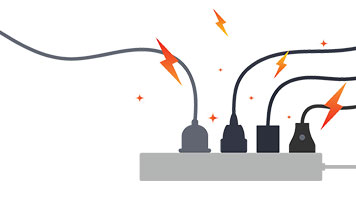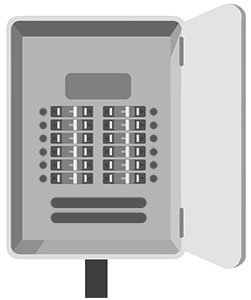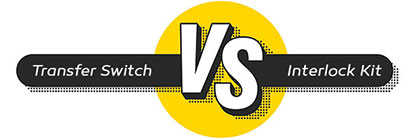If you are wondering what is the safest way to connect a portable generator to your home, RV, or private business, then read along. Power availability is of utmost importance. Occasionally, though, the power grid is faced with challenges that lead to unpredictable power blackouts.

You are busy watching your favorite program, listening to nostalgic songs, or simply playing video games and voila – the power goes off! Before you could comprehend or even think of what next, power comes back almost instantly. Well, this process is made seamless by the use of transfer switching systems.
There are a few ways that can be used to connect a generator to a house. You can find several ideas and guides offered on the internet in this regard. However, some can lead to hazardous outcomes. That said, this is not an instructional manual, rather it’s a general guideline to shed some light on the safest and most common methods used.
30-Second Summary
Powering your house using a portable generator during a power outage is made easy using these methods:
- The safest and most convenient way is to use a generator transfer switch.
- The budget-friendly alternative is to use a generator interlock kit.
Consult a certified electrician to learn more about the electrical codes in your area. It’s also important to note that wiring installations for these devices require hiring a professional electrician.
Connecting a generator to an electrical panel
As you should know, connecting a portable generator directly to your main electrical panel, washing machine or dryer outlet can cause back-feed, which occurs when power travels back from your generator down the utility power lines.
This has the potential to damage your generator, connected appliances, and even worse cause fire or risk any utility worker who may be working on the power lines. Thus, your home cannot connect to both a generator and utility power at the same time.

When a power outage occurs, running a portable generator in a hurry often means choosing the most basic route and make do with extension cords. However, generator extension cords are not the safest option. Also, they limit the appliances that you can power.
Additionally, portable generators cannot power hard-wired appliances, such as air conditioner units or water heaters. So to get over these hurdles, we will explain the safest methods for powering your home with a portable generator. That said, before making any decisions, consult your local licensed electrician as electrical codes and regulations may vary.

What is a transfer switch?
A transfer switch is an electrical device that is typically installed right next to the main electrical panel in your home. It switches loads between two sources of power. In this case, it switches power between the generator and utility lines.
Generally, electricity flow is supplied from the utility lines into your electrical panel in your home. The electrical panel, also known as the breaker box, is responsible for protecting and distributing the electricity flow across different circuits and out to different rooms.
Here is where a transfer switch comes in handy. It prevents power from the utility lines traveling back to the generator, as well as, power from the generator traveling back to the utility lines. It blocks one source and loads the other.
Additionally, it allows the backup generator to power entire circuits, rooms, or appliances. A transfer switch provides a safer way to power your electrical devices in your home, motorhome, or boat.
Why do I need a transfer switch?
Here we will discuss the importance of transfer switches and why you may need one. Well, first of all, a transfer switch is the best option in terms of power, safety, and convenience. They can power hard-wired appliances, such as the furnace, garage door, and well pump.

- A transfer switch is required by the National Electrical Code (NEC) to transfer loads between utility and emergency power sources. It should be properly installed and have adequate capacity to avoid any code violation.
- A transfer switch is the safest way to connect to an electrical panel. It manages power distribution by isolating the power coming from the generator and the utility lines. Thus, eliminating the risk of back-feed, which is the primary concern.
- Also, the easiest, since most of your electrical appliances at home are hard-wired, such as the furnace or air conditioner. Without a transfer switch, you cannot connect them to a generator using extension cords.
- Installing a transfer switch for your home is one of the fastest methods to switch between power. It is a seamless process that will give you a consistent power supply. Plus, high functionality, especially if you live in a power outage prone area. They also come in handy for powering entire homes, institutions, factories, and hospitals.
- Installing a transfer switch for your RV is also useful. Recreational vehicles follow two methods of introducing 120 volts power. One way is through the shore power cord and a ready generator for RV camping. A transfer switch ensures that power is supplied separately from each power source. When the switch has a command to start, it will automatically drop the incoming feed and pick up the outgoing feed. Transfer switches used in RVs come in 50 amps and 30 amps.
How does a generator transfer switch work?
Using a generator cord, you plug your portable generator to the inlet box, which is essentially an electrical outlet mounted to the exterior of your house. The inlet box acts as a connecting link between your generator and transfer switch. Which then allows the transfer switch to carry the load to the specified circuits.

A transfer switch is integral to the basic functioning of a generator at a house or elsewhere. Most people are not aware of what a transfer switch is or does. There are outdoor transfer switches and indoor transfer switches according to their NEMA rating, which specifies their installation location. They come in both automatic and manual setups.
Whichever type you choose, we highly recommend hiring a professional electrician for the installation. Otherwise, you could risk violating your insurance or your city regulations. Not to mention, if not installed properly, it could lead to serious damage.
To explain the difference between manual and automatic transfer switches, let us explain how they work. Make sure to read the owner’s manual provided with your product thoroughly before operating.
Connect Generator to Home: Manual models
Manual transfer switches are available in different sizes and models. When installing a transfer switch, the electrician will ask you if you would like to assign different circuits to each room or appliance. So it will be easy for you to handle and control the power usage of your generator. Then during a blackout, you can manually turn circuits on and off to manage the load on the generator properly. Manual transfer switches are typically more affordable due to their low installation cost.
A manual transfer switch works as follows:
- When the power goes out, start by turning off all the circuit breakers in the transfer switch.
- Using a generator cord, connect your portable generator to the transfer switch or inlet box.
- Then run the generator and allow it to warm up.
- Next, flip the main breakers in the transfer switch to the generator power position.
- Now, start turning on the circuits you want to power. Make sure to do this one at a time to avoid overloading the generator.
- When the power is restored, you simply flip the main breakers in the transfer switch back to the utility power position.
- Then turn on any other circuit breakers that were turned off.
- Finally, shut down the generator and disconnect any cords.
Connect Generator to Home: Automatic models
Automatic transfer switches, on the other hand, automatically handle a big part of the previous process. There is no need to flip circuits manually. It will optimally adjust the power flow to avoid overloading the generator.
It allows you to set a group of essential appliances, and it will automatically adjust the power supply according to their priority. So it will turn one item off and another on.
An automatic transfer switch (ATS) is also known as a universal transfer switch (UTS). They are convenient for managing power usage. They maximize your generator’s performance by allowing you to set the power supply to specific rooms, circuits, or the entire house service panel. That said, an automatic transfer switch usually requires a dedicated full-house generator.
An automatic transfer switch works as follows:
- When the power goes out, the automatic transfer switch instantly detects power loss and commands your generator to start.
- Once the generator is ready to provide power, the automatic transfer switch will automatically move the load to the generator and handle the circuits as required.
- When the utility power is restored, it switches back to the grid and commands the generator to shut down.
Many brands widely manufacture household transfer switches. They come in various sizes to match your generator, including ones that can fit inverter generators, as well as home standby generators. The most popular residential transfer switch sizes are the six-circuit, eight-circuit, and ten-circuit switch, which are suitable for 5000W and up to 10,000W generators. A manual transfer switch cost is about a few hundred dollars, including labor. While an automatic transfer switch cost can easily go up to a thousand dollars.

Alternatives to transfer switches? What is an interlock kit?
Due to the high costs of installing a transfer switch, service panel manufacturers produced a small connector device referred to as the interlock. Each interlock kit is designed for a specific electric panel model, but mostly they all function in the same manner. The interlock device connects a portable generator to the service panel without the use of a transfer switch.
However, interlock devices are not legal in many areas. Consult a licensed technician to learn more about your local building codes and permits. If approved, then you must find an interlock kit that is compliant with the National Electrical Code (NEC) and specific to your electrical board. They should also have the UL approved mark. Generator interlock kits must also be installed by a professional electrician to meet all applicable electrical codes in your area.
Connect Generator to Home: How does a generator interlock kit work?
It consists of two sliding plates held together by three bolts. Once placed in position, the interlock device covers the main service panel cutoff switch. That means there is no direct connection, and the power can only flow in one direction. Therefore you cannot switch on the main power supply while the generator is on. Once the power is back, you can safely flip the interlock to its original position.

The primary purpose of an interlock is to act as a back-feed breaker. As we mentioned, back-feed occurs when power travels back down the utility line, and vice versa. This has the potential to damage goods, cause fire, and more.
Interlock devices for portable generators eliminate the use of various extension cords to different appliances. They also allow you to activate all the circuit breakers in your electrical panel. Always be sure to read the product’s manual, it will offer you detailed instructions on the proper operating procedure.
That said, the operation of a generator interlock kit is more manual than say an automatic transfer switch. Additionally, for a proper interlock installation, it requires you to have extra space in your existing breaker board. The electrician installing the kit may ask you to install a bigger panel to accommodate the interlock.
An interlock device works as follows:
- When the power goes out, you start by turning off the main breaker, as well as all the sub-circuit breakers.
- Connect the generator cord to the outdoor inlet box outlet.
- Then run the generator and allow it to warm up.
- Next, slide the interlock plate to on position and turn on the generator breaker.
- Now, turn on the circuits that you will need, one at a time. To avoid generator overload, you should also allow the appliances to start up before turning on other circuits.
- When the power is restored, you turn off the main breaker and all other circuit breakers.
- Slid the interlock plate to the off position.
- Then turn on any other circuit breakers that were turned off.
- Finally, shut down the generator and disconnect any cords.
Interlock kits can handle any generator size. It’s also best to look for interlock kits manufactured by the same generator brand. An interlock kit cost usually maxes out at a couple of hundred dollars, including labor.
Transfer Switch vs. Interlock Kits

A transfer switch and an interlock kit have many things in common. For starters, both of these methods allow you to connect your portable generator to your house safely. And, essentially, prevent power from back-feeding into the utility lines or the generator, which can lead to substantial damage, to say the least.
The main difference is in the total cost. A transfer switch installation cost is much higher than an interlock kit. However, it’s well worth the investment. Installing a transfer switch requires enough room on the wall next to your service panel to fit a separate transfer switch panel. On the other hand, an interlock kit requires enough space inside the service panel to accommodate the interlock kit. Additionally, generator interlock installation requires modification to your main electrical panel, such as drilling holes that cannot be undone in case of uninstallation.
In terms of convenience and ease of use, an automatic transfer switch is a winner. It allows for a fully automated process. However, it typically requires a full-time connected home generator. When it comes to a manual transfer switch, it’s the best of both worlds. It’s more affordable and still allows for some automation. That said, one common thing between manual transfer switches and interlock kits is that it’s hard to know when the utility power is back. Unless you check your neighbors or purchase extra gadgets that can notify you when the power is back.
Connect Generator to Home: Safety

As a measure to curb the risks associated with carbon monoxide (CO), manufacturers have designed inbuilt sensors that automatically shut down the generator when there are unsafe levels of CO. Even though these measures have helped to reduce the risks. However, some loopholes need to be checked to create safer environments for generator users.
One safety measure is to place the generator outdoors within twenty feet from your home with the exhaust directed away from any opening in the house. Generators should never be used indoors or in enclosed places. Generator owners are also advised to install CO detectors in their living spaces for monitoring CO levels. Check our FAQ page for more questions and answers.
Connect Generator to Home: Conclusion
If you are not familiar or you are not confident in your understanding of the basic principles of generator power management, then you should consult a qualified electrician. Ultimately, your safety and that of the family is the most important thing.
There is no doubt that a transfer switch plays a significant role in ensuring safer running generators. With the development of the industry, new ways have been achieved to make it easier for people to safely power their homes with portable generators, such as the interlock kit. We hope we could shed some light on the safest ways to connect a portable generator to a house, and more.

